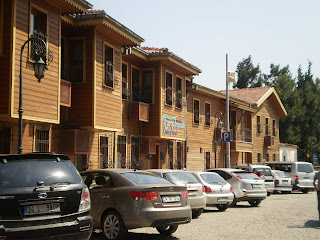I visited the Archeological Museum, and boy was it far more than I expected. I really wished, as I walked from room to room of the 3 or 4 story building, that I had paid more attention in History class and could grasp the periods of events and understand more about each piece. I will be taking more trips to the museum to learn a little bit at a time. For now, here are a few pictures with some basic notes.

The actual Archeological Museum is the building above. It extends to the right about triple as long as this picture shows. There are at least 2 other museums in the area: The Tiled Kiosk and The Museum of the Ancient Orient.

This is the Alexander Sarcophagus. It was believed that this was actually the final resting place of Alexander The Great, but apparently they have disspelled this rumor.

An image of Alexander the Great on his horse. What I found interesting, and will have to learn more about, is that everyone had clothes on in these images, except for the Macedonian soliders. I guess it is to represent the "enemy" but I don't know.

A color representation of all of the images around the sarcophagus.

A statue of Alexander the Great.

The "Mourning Women" sarcophagus. The detail was great. And their expressions were somber and it seemed like they were remembering the person they lost.

There were so many tombs in the museum.



The picture above is one of the many actual skeletons I saw. There was no explanation as to who it was, but I didn't really need to know.
The picture below is of Zeus. I am very unfamiliar with Greek Mythology, so I will spend more time in this area of the museum in the future!

Below: A sculpture of Oceanus.

There was a display of all money used in Istanbul since 500BC. I found this display very interesting. The coins were very simple. A piece of gold or silver with a slight indent or image. An image that was popular when the currency was first created was an image of a bull standing on a dolphin. I tried to research this a little to find the story behind it, but couldn't find any certain facts. So, I am going to go with my assumption that the significance of the bull on the dolphin was to represent the proximity of Istanbul to the water. The reason currency was established in Istanbul was because Istanbul was a great location for traders from other countries. The traders would sail in from all around and trade their land good with that of Istanbulians. So, dolphin (water) and bull (land). That's just my explanation.

The painting below is of historic Istanbul hundreds of years ago. The water on the bottom of the painting is of the Bosphorus. The water that comes from what seems like the north, but is really the west (as the picture is actually with the West on top) is the Golden Horn. Obviously, the area has changed quite a bit in the hundreds of years that have past, but you can still very well understand how this area used to look. Many of buildings still exist...along with many others. And the walls have been taken down.

So maybe I'm being a little too courageous, but the floor mosaics they had displayed in the museums made me want to make one myself. I really would like to try this sometime. Maybe I'll start with a simple mosaic...8x10 picture?







































